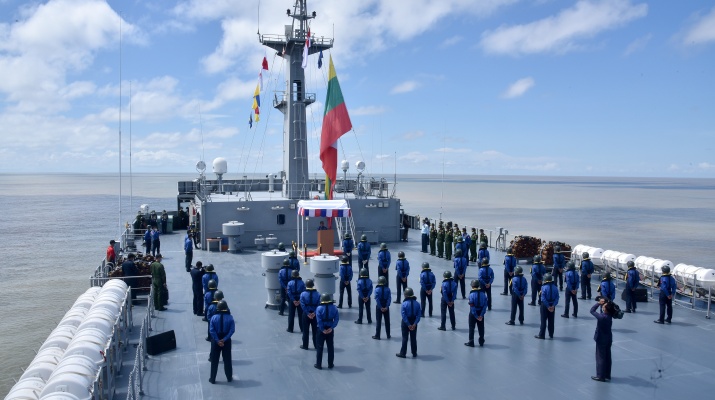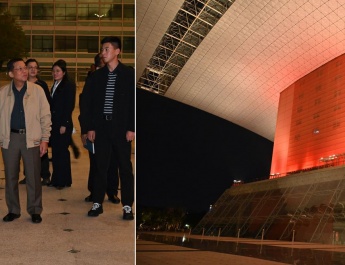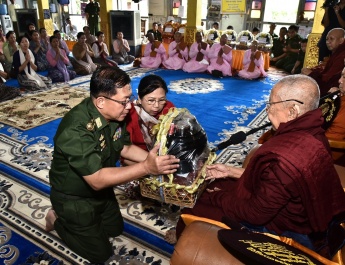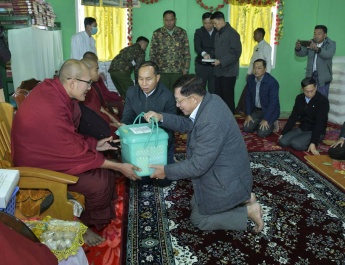Nay Pyi Taw October 15
The Tatmadaw is constantly conducting (Army, Navy and Air) military drills in enhancing defence prowess to safeguard the sovereignty and territory of the State. Today, the Tatmadaw launched the Fleet Exercise-2020 in the Myanmar territorial waters with the participation of attack submarine Minye Theinkhathu of the Tatmadaw (Navy). Commander-in-Chief of Defence Services Senior General Min Aung Hlaing wearing the Navy uniform in honour of the Tatmadaw (Navy), closely watched the Fleet Exercise-2020 from the Mottama observation vessel together with Deputy Commander-in-Chief of Defence Services Commander-in-Chief (Army) Vice-Senior General Soe Win, Commander-in-Chief (Navy) Admiral Tin Aung San, Commander-in-Chief (Air) General Maung Maung Kyaw, senior military officers of the Office of the Commander-in-Chief and the commander of Yangon Command.
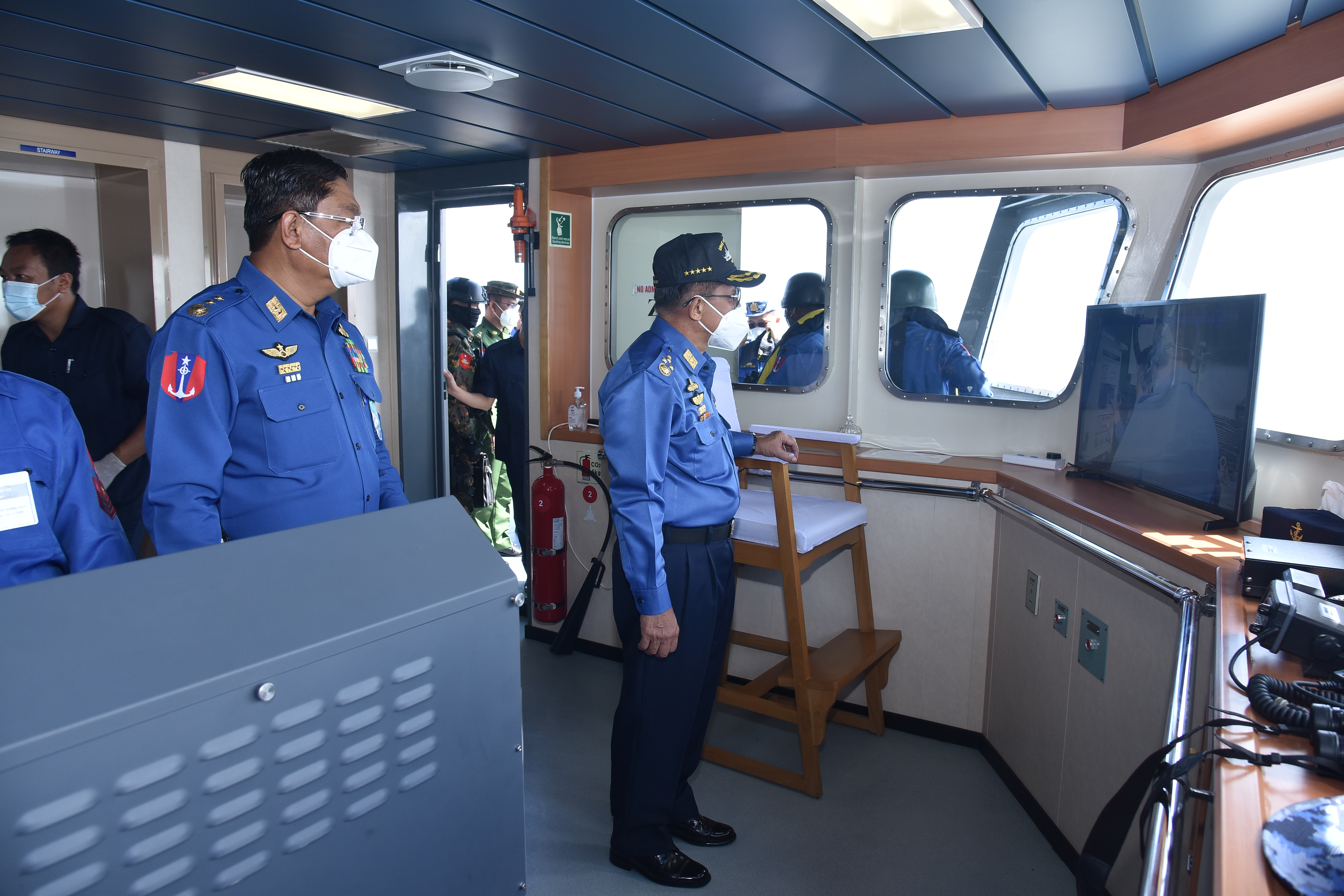
The Senior General and party arrived on board the naval vessel Mottama by helicopter, and were welcomed by Commodore Zwe Win Myint, Commander of the Task Force Division leading the Fleet Exercise-2020 and members of the Task Force (Navy). The Senior General and party then observed the process of the military drill from the naval vessel. Submarine Minye Theinkhathu and other naval vessels of the military exercise in a Fleet Review formation saluted the Senior General who was on board the Mottama. Later at the Mottama meeting hall, Commodore Zwe Win Myint reported on exercise that began on 12 October, and the Commander-in-Chief (Navy) on the salient points of the submarine and the improvement in the military prowess in conducting an underwater military drill with the participation of a submarine.
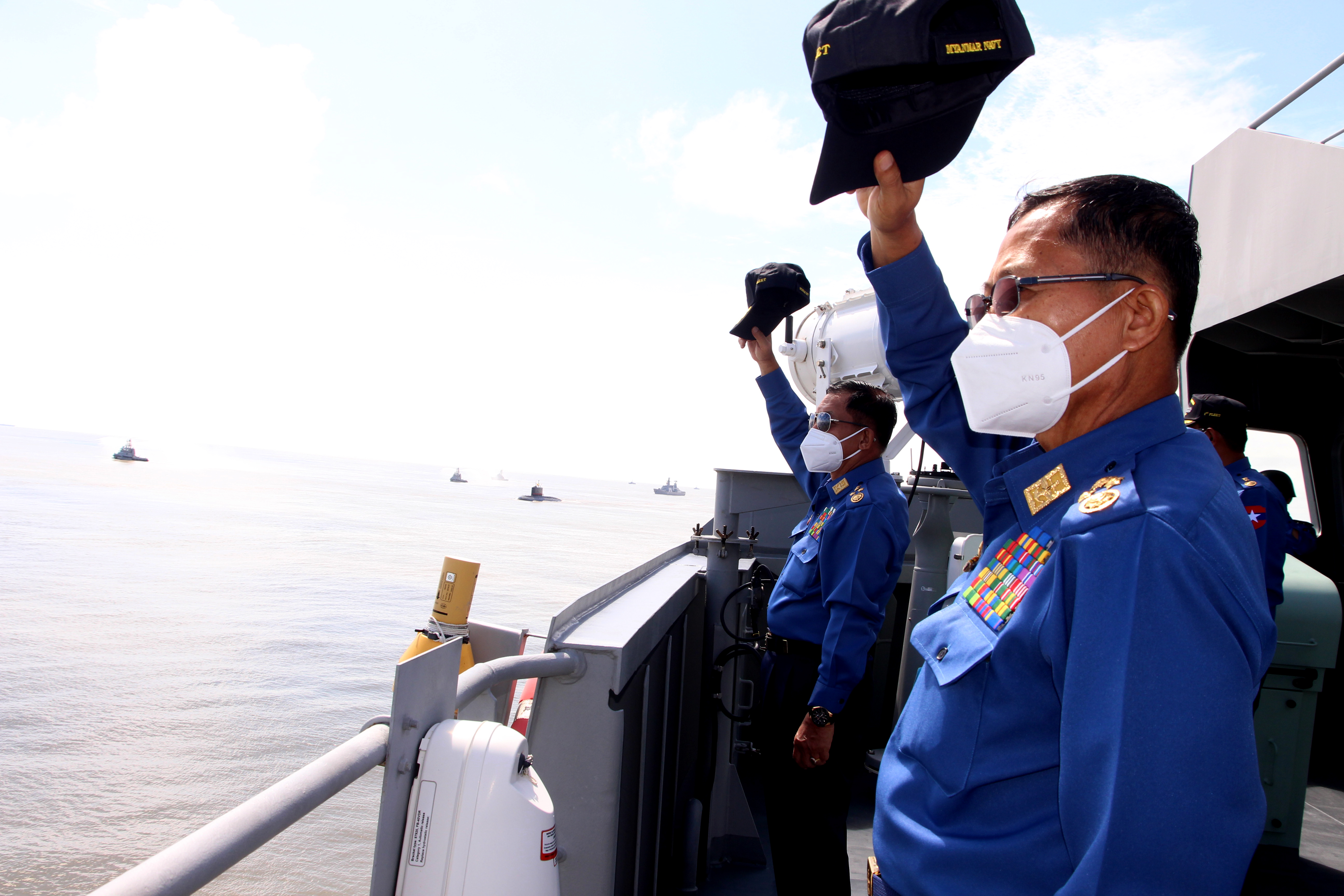
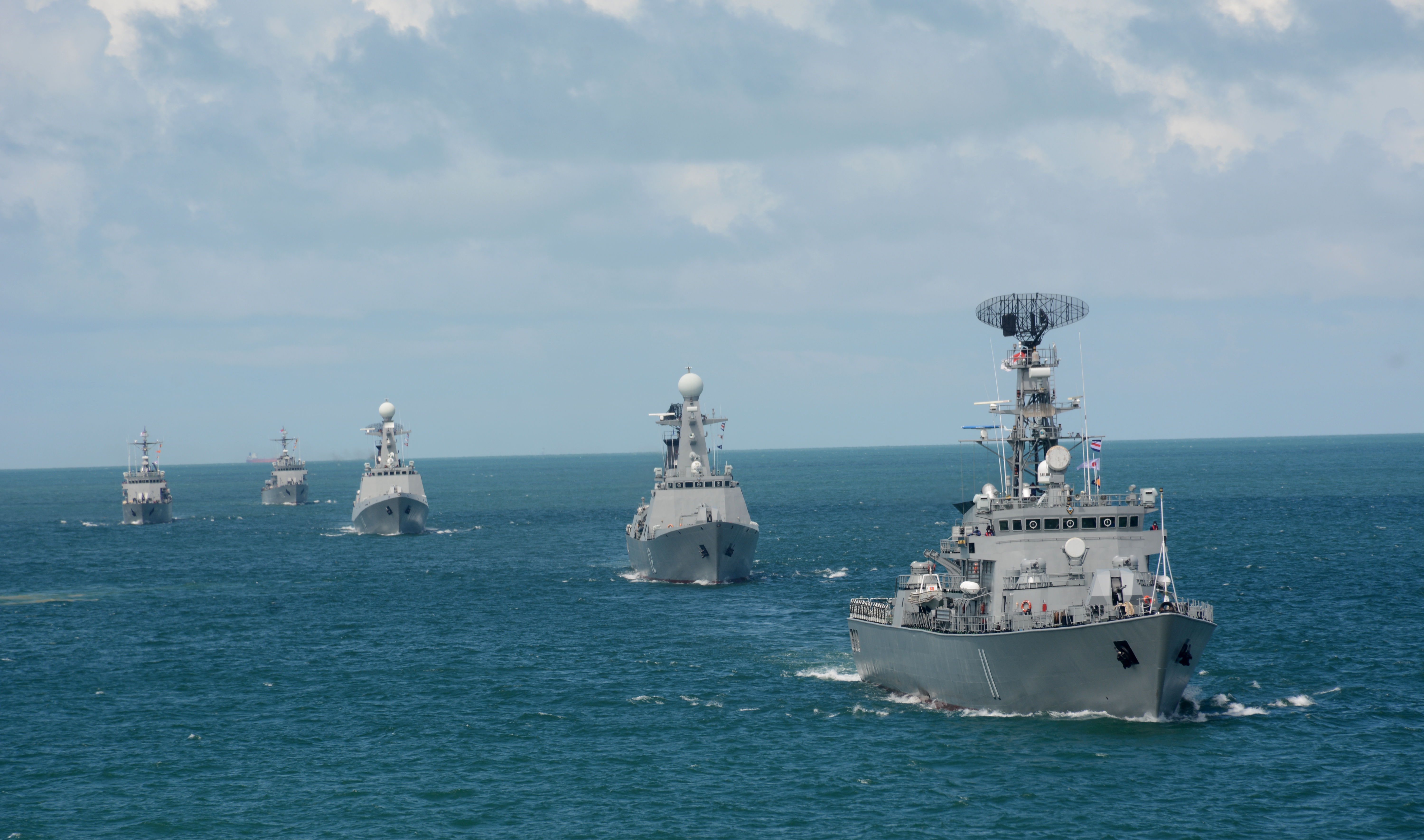
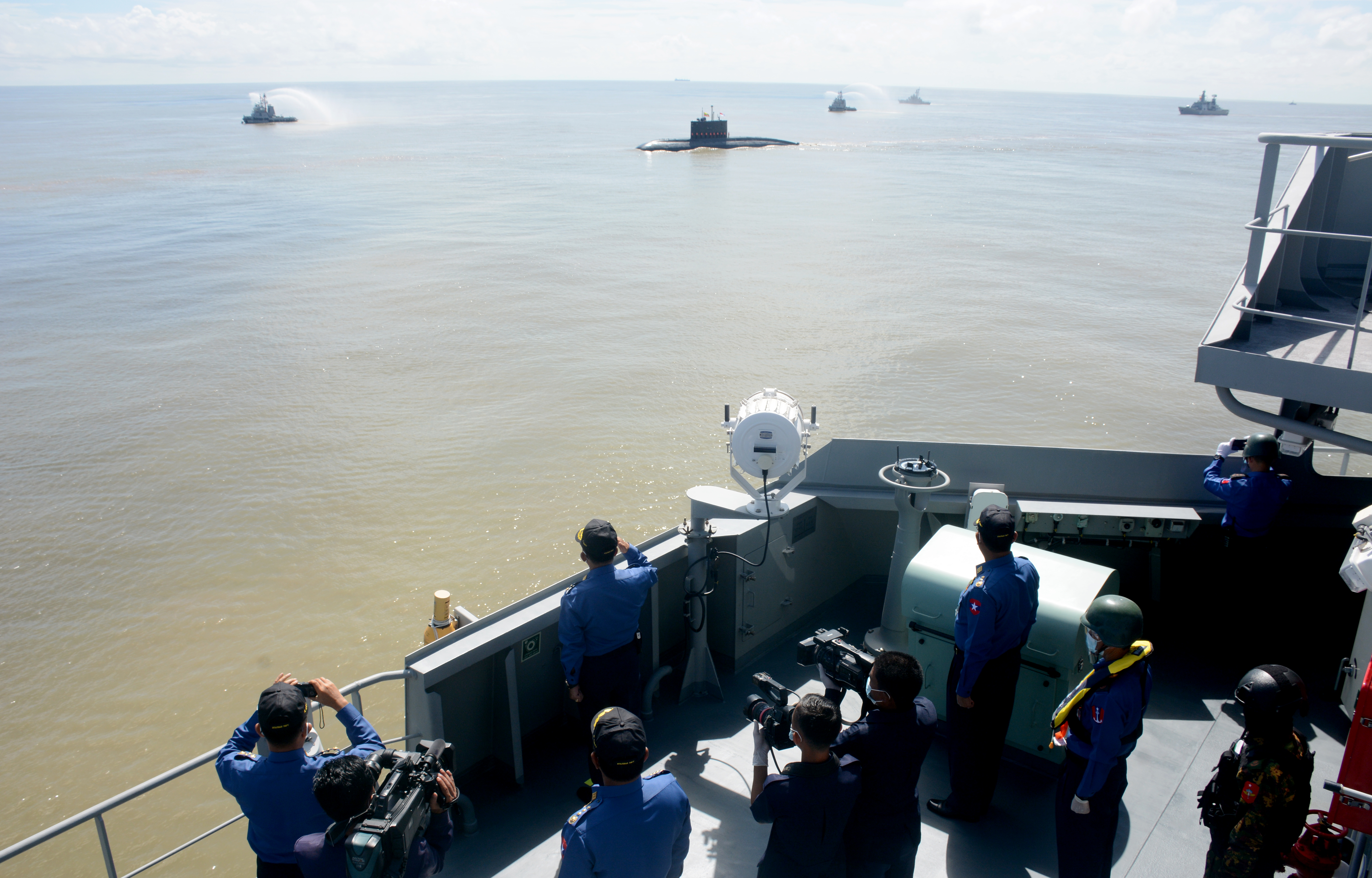
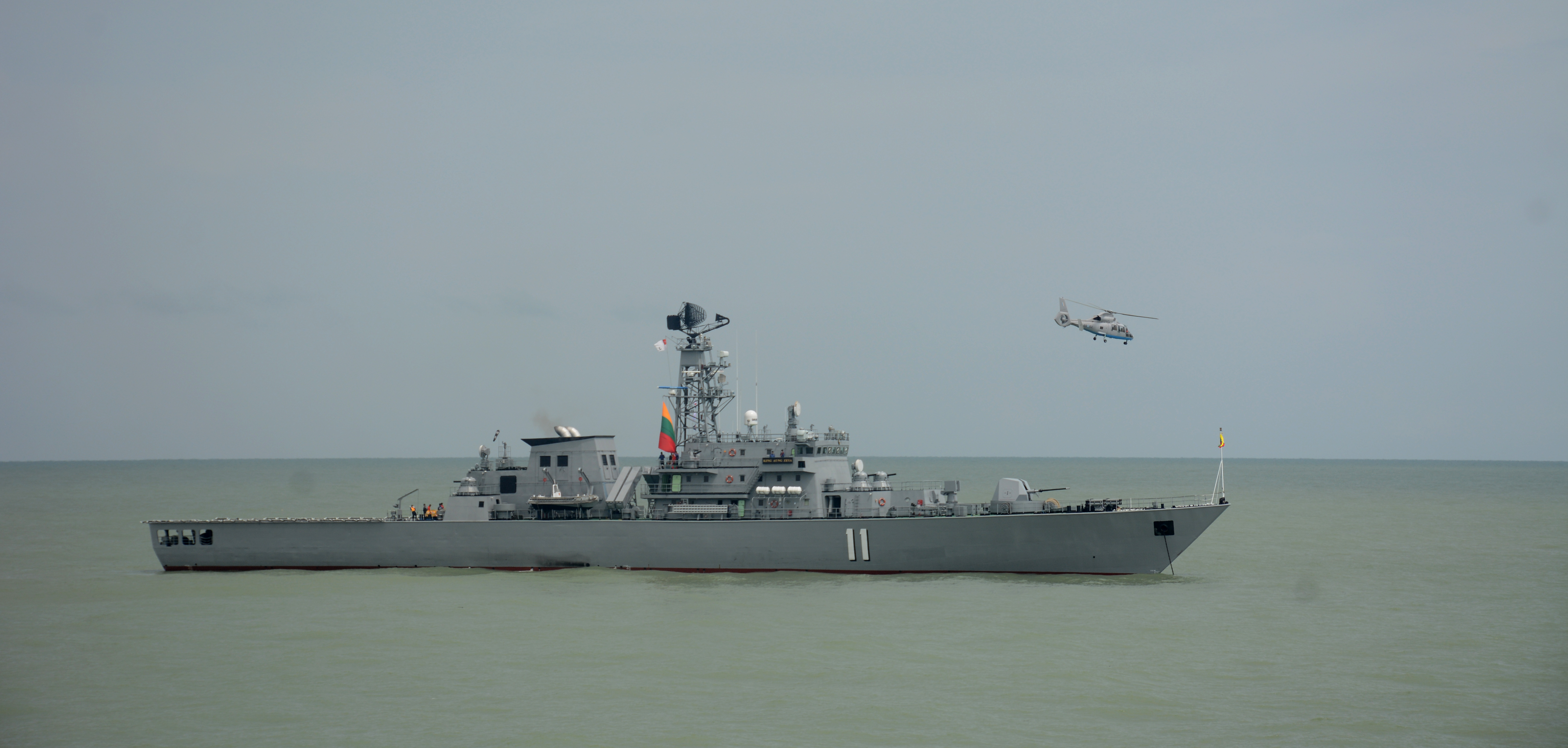
Afterwards, the Senior General gave a speech on the review of the Fleet Exercise-2020 to commanding officers and other ranks of naval vessels who took part in the Fleet Exercise-2020. He said today is a milestone in the history of Tatmadaw (Navy) as it is a new step towards reaching the Blue Water Navy, which is the goal of the Tatmadaw (Navy). Every country is striving to promote its naval power. To reach this end, it must enhance its naval strength by possessing powerful naval vessels, and the submarine is also included in them. Establishing a naval force is not an easy task. Because it includes an all-angle overview of the task of building the ship, equipping it with weapons, assigning the naval persons specific duties, and providing quality trainings, which takes time. As regards the submarine, the task is even harder. The sailors on board a submarine need stronger mental and physical abilities when compared with personnel of other ships. The Tatmadaw (Navy) was established in December 1947 and the changes in its naval ships showed that it became a navy that can stand shoulder to shoulder with other navies in the 1990s. So it has to take much time to reach that situation. Submarine is requirement for further modernizing the Navy. The Senior General then recounted the efforts to own a submarine.
“To be more modernized navy, a modernized navy must be facilitated with submarines. We have been trying and considering to possess submarine for many decades. Such dream could not be shaped easily. We tried very hard for the dream to come true. We could not shape the dream for many decades due to various difficulties. In my tenure of the Commander-in-Chief of Defence Services, I tried to implement such project. It is necessary to consider that the first point is how to search human resources and the second point is how to choose the submarine suitable for the country and where it can be available. Consideration was focused on such process. Now, it can be said that characteristics are full of factors to emerge a submarine corps. The submarine has been named Minye Theinkhathu which was chosen to bravely launch maritime warfare.”Power of the navy is measured by war vessel. If there is no war vessel, the navy will not have power. These war vessels must have high power by showing fighting capability and fully discharging maritime duties. Only when the navy is formed with river craft as well as frigates, will it have capability to guard the water territory. The country teeming with many rivers, creeks and islands possesses about 1,300 nautical miles of coast. To be able to guard such wide area, it is necessary to own not only large vessels but also small vessels capable of discharging duty in rivers and creeks. Myanmar’s water territory is more than 144,000 square nautical miles. Only when the navy comprises not only frigates but also submarines to safeguard the wide water territory, it will be modernity. In the task of protection, war vessels need to collectively discharge duties.
Nowadays, the combined warfare technologies are being applied. Although infantry is main troop on the ground, evidences in the First and Second World Wars showed comprehensive warfare of the infantry troops combined with artillery, tank, armoured and air defence forces in military operations. It can be seen that joint warfare was launched by infantry troops together with paratroops with the aid of air force in some areas.With regard to naval sector, a single vessel cannot be fighting. In their nature, vessels must be grouped to fight. Aircraft of air force are flying in groups to fight. High-qualified aircraft can be fueled in the air for fighting. When naval vessels are not sufficient of fuel, they are supplied with fuel and ration from carriers to discharge duty in the sea. It means combined efforts. Today, the naval exercise was launched with participation of 12 naval vessels. Joint exercise is of great important. It is necessary to take exercise with correct techniques, and the naval exercise is more comprehensive due to participation of special war vessel called combat submarine Minye Theinkhathu. It was known that Minye Theinkhathu has taken underwater exercises for about 100 times. So, it is necessary to thoroughly take exercises. The naval corps alone cannot defend the wide water territory completely, and as availability of information is of important, the wider exercises must be launched. Enemy, natural disaster and factors to cause virus may happen at any time.
So, anyone cannot stop it due to lack of readiness. As such, all need to always carry out the tasks in accord with three kinds of constant duties and three kinds of readiness. Hence, it is necessary to make preparations. If it is no adequate time to make preparations, they must overcome challenges through combined efforts. Regarding the needs of always learning, training and following various situations, the Commander-in-Chief of Defence Services continued his speech as follow:-“When it comes to the Tatmadaw, Section 341 of the constitution says Tatmadaw shall render help if disaster befalls the people and the State. Disaster means all things I have said now. This is why the Tatmadaw must always be ready to help and train. For example, if an epidemic occurs, all medical corps must train. They have to adapt to changes after seeking all information. I talked about the three tasks of the Tatmadaw when I became Commander-in-Chief of Defence Services. These are to learn, to train and to follow. We must learn sophisticated military weapons and equipment. They are being developed not only in our country but also in other global countries.
We must learn how they are developing their weapons. What changes are they making? We must be familiar with those changing military equipment and weapons. For example, firing a rifle and an automatic gun is different. In canon firing also, systems are different as time flies. For example, OTO Melara firing capacity was low in the past. Now it is high. They can get a target automatically. We can see how many bullets can be fired per minute. In the past, firing was easy. Now it is very fast. So we need to train to be familiar with them. This is why we must learn first. Train second and follow third. There are fundamental facts regarding those military equipment and weapons. To put it simply, there are basic concepts in warfare. Regardless of offensive, marching, defence or retreat, they all have their basic concepts. There are such concepts in the navy as well. Unless we follow them, we will get into trouble. Follow these basic concepts. So, I would say learn, train and follow.”
Since the role of submarine Minye Theinkhathu has come now, training will include underwater exercise. So we have honour for the country and the Tatmadaw. Today is a historic and landmark day for the history of Myanmar, the Tatmadaw and the Navy. Tatmadaw’s main duty is for State security and defence. This does not mean combat alone and it is very wide. So you must improve your capacity understanding the nature of security and defence. Tatmadaw (Navy) plays an important role in safeguarding Our Three Main National Causes. Therefore, all must always train themselves to achieve high calibre. All must be at the forefront to protect the natural resources in the territorial waters. Then, the Commander-in-Chief of Defence Services made a concluding remark expressing wishes for the historic and landmark day of the State.
“I wish you all be greater progress and success on such a historic day for our Tatmadaw (Navy), Tatmadaw and country.”Then, the Senior General presented gifts and cash rewards for officers and other ranks who participated in the fleet exercise . Afterward, the Commander-in-Chief (Navy) presented gifts commemorating the fleet exercise to the Senior General, the Vice-Senior General, the Commander-in-Chief (Air) and senior military officers, and the Senior General signed the book of distinguished guests before leaving Mottama Warship.
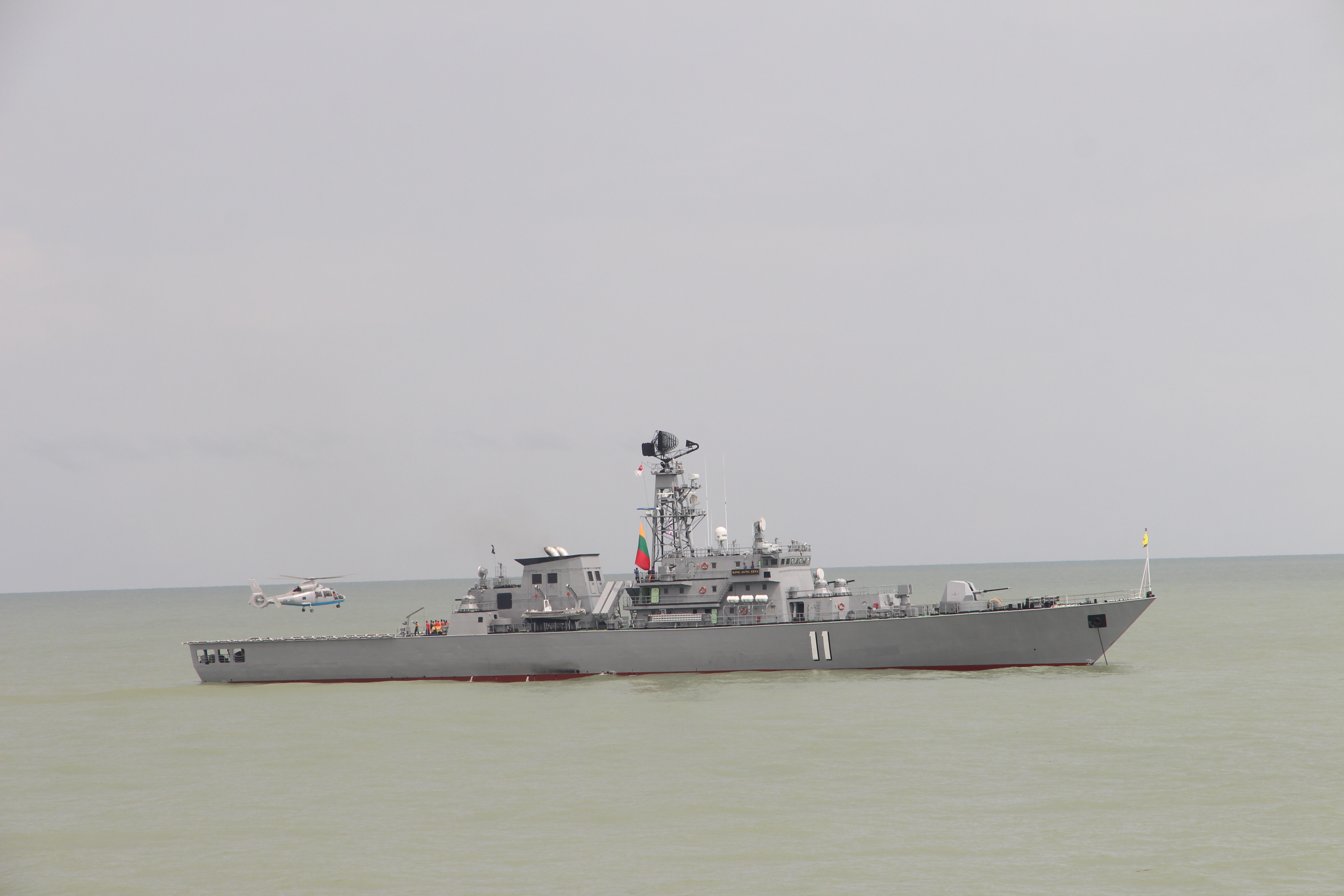
To protect the country from potential hostilities caused due to her strategically important location in controlling one of the geographically important regions, Asia-Pacific, growing interest and presence of super powers in the Indian Ocean and abundant natural resources under and above waters and maritime interest, the Tatmadaw (Navy) conducts naval exercises constantly for the combat readiness in aerial warfare, naval warfare, underwater warfare and electronic warfare.Fleet Exercise-2020 featured phase-by-phase electronic warfare drills, anti-submarine warfare drills while warships advancing in formations, drills for defending against air-to-surface missiles, antiaircraft warfare drill to defend the air defence systems, naval warfare drills to destroy enemy warships with surface-to-surface missiles and artillery warfare. Moreover, joint operation drills of the submarine and warships were also conducted during the naval exercise.
Prior to Fleet Exercise-2020, Submarine Minye Theinkhathu had carried out surface and under-water navigations more than 100 times and had successfully fired torpedoes at the target warship on the surface detected by sonar sensor in the Indian Ocean. Helicopters from the Tatmadaw (Air) took part in the naval exercise by conducting aerial patrols, landing on and taking off from Mottama Warship, cross-deck landing on and taking off from Mottama Warship to Frigate Aung Zeya to improve the air-to-surface reconnaissance capability.


